Introduction
Among other functions, CAN-8 allows instructors to monitor the students and their progress via its Tracker screen.
This chapter discusses the different options and tools available to the instructors to facilitate students' monitoring, to change the lesson mode from practice to test, to view the students' progress, listen to their recordings and assign them marks.
Familiarity with the previous chapters of this manual is strongly suggested before starting this one as it refers to topics previously addressed.
About the Tracker
The Tracker Screen allows an instructor to:
- See the names of all the students who have accessed the
lesson and identify those currently signed on.
- See a graphical display of the progress of each student
as they go through the lesson.
- Print the students' progress.
- Select and listen to each recording made by a student.
- Select and see any incorrectly answered Multiple Choice
and Fill-in questions for a student.
- Select an item for a student and record special instructions
for that student. The student is then directed to the selected item
and given the special instructions.
- Speak in real time to the whole class.
- Talk individually with a single student.
- Enable a class or individual test, monitor students taking the test, mark answers and review the test.
- Control data display and storage for students accessing
the lesson.
Accessing the Tracker
To access the Tracker, chose any one of the 3 following options:
 First select a lesson from the main CAN-8 menu, and then press the Tracker icon located in the tool bar on the left of the interface.
First select a lesson from the main CAN-8 menu, and then press the Tracker icon located in the tool bar on the left of the interface.
 Select the lesson title from the main CAN-8 menu, right click on it, and then select Track Item from the contextual menu.
Select the lesson title from the main CAN-8 menu, right click on it, and then select Track Item from the contextual menu.
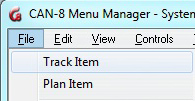 Select the lesson title from the main CAN-8 menu, and then select File > Track Item from the menu bar.
Select the lesson title from the main CAN-8 menu, and then select File > Track Item from the menu bar.
Note:
 If the Tracker button or Track Item option is greyed out,
check that the lesson is selected (highlighted blue in the tree menu).
If the Tracker button or Track Item option is greyed out,
check that the lesson is selected (highlighted blue in the tree menu).
 Make sure that the item you are trying to track is a lesson
Make sure that the item you are trying to track is a lesson  and not a submenu, an internal command, or some other type of CAN-8 function.
and not a submenu, an internal command, or some other type of CAN-8 function.
Navigating within the Tracker
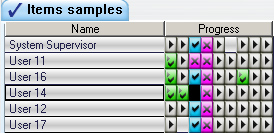
The blinking cursor indicates which student and which item is currently
selected. The user cell is surrounded with a black border, and the cell where the cursor is placed blinks.
In this example, the cursor is on the third item box for User 14.
The Up, Down, Left and Right arrow keys of the keyboard can be used to move the cursor from student to student or from cell to cell. The Enter key opens the content of the cell.
Alternatively, the cursor can also be moved by mouse clicking on a different cell.
 The currently selected item is identified at the bottom left corner of the screen. The item index in the plan is followed by the item name (or title). The mark given for the response (if any) is shown over the assigned mark (if any) for the item.
The currently selected item is identified at the bottom left corner of the screen. The item index in the plan is followed by the item name (or title). The mark given for the response (if any) is shown over the assigned mark (if any) for the item.
The Tracker's Interface
The Trackerís interface is placed within the user's main work area, thus leaving the
UserísTab Bar
visible and available at all times for the instructor:
 This allows to easily switch from a Tracker to a lesson, a planner or even another Tracker without having to exit the Tracker screen.
This allows to easily switch from a Tracker to a lesson, a planner or even another Tracker without having to exit the Tracker screen.
Tracker tabs  can be easily identified by the icon located on their left. Since up to 7 tabs (including Planners, Trackers and Students Programs tabs) can be opened simultaneously,
this helps locate opened Trackers at a glance. The lesson's name also shows on that tab for more clarity.
can be easily identified by the icon located on their left. Since up to 7 tabs (including Planners, Trackers and Students Programs tabs) can be opened simultaneously,
this helps locate opened Trackers at a glance. The lesson's name also shows on that tab for more clarity.
A blue tab (as in the image above) shows which tab is presently active. Tabs are otherwise grey.
The Tracker's interface is composed of:
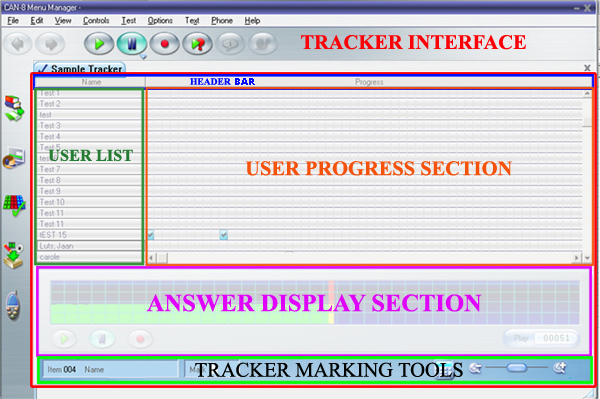
|
- A Header Bar that that references the information displayed below. Also used to sort the information by category and relevance.
- A User List, where the name of all users who have accessed the lesson are displayed. and their status: offline or online.
- A Progress Area where users' data is displayed by colour code on a per item basis.
- An Answer Display section, where the students' recorded data can be viewed or listened to:
- If it is audio data, a sound graph is displayed with the student's answer, as in the illustration.
- For written answers, this section displays a text area with the students' typed answers.
- A Marking Tools section, where tools are available to assign marks to answers, calculate mark totals and change the view of the Tracker cells.
|
NOTE:
 It is important to be familiar with the layout of this interface and the names that have been given to each area of the Tracker as they will be referred to all along this chapter. It is important to be familiar with the layout of this interface and the names that have been given to each area of the Tracker as they will be referred to all along this chapter.
|
The Header Bar
This header bar is divided in several sections, each describing the data displayed.
There are 3 different headers:
- Name. Under that header is the list of users who have accessed that lesson since the last time the Tracker was refreshed or the system first installed.
- Progress. The data in that section is displayed as colour coded cells. Each cell in that area represents one exercise (or lesson item). The entire section, made of coloured and/or empty cells, represents the entire lesson.
- Mark. Marks listed in this column represent the mark per user for a specified section of the lesson.
- The Mark section can be absent if there is no need to score the results.
- There could be more than one Mark field in the header bar if it is necessary to mark the test by subsections. In which case, the Mark listed in the column below is the sum from either the first cell (or item) to the last cell directly before the the Mark section, or from the first item after the previous mark section, to the last cell directly before the new Mark section.

Each of these headers can be clicked on to sort the information listed under.
- If you click on the Mark header, the information is listed from the highest mark to the lowest one.
The User List section.
This section displays the
names of all students who have accessed the lesson since the Tracker was last refreshed, and their data is kept available until deleted.
By default, users are listed by the order in which they signed on to the lesson. However if you click on the Name header, the list will be sorted alphabetically.
User status.
Users names are displayed on different background colours depending on their status:
 If the student is currently signed on, the name is displayed in Black on a blue background.
If the student is currently signed on, the name is displayed in Black on a blue background.
 If the student is currently taking a test, the name is displayed in Black on a green background.
If the student is currently taking a test, the name is displayed in Black on a green background.
 If the student has accessed the lesson in the past but is no longer signed on, the name is displayed in black on a white background.
If the student has accessed the lesson in the past but is no longer signed on, the name is displayed in black on a white background.
 If the student is calling for help the name is displayed in black on a red background.
If the student is calling for help the name is displayed in black on a red background.
Customized Student List Display
Over time, the student list may become too large or cluttered to easily view the progress of only the few students the instructor wishes to monitor or it may be preferable to view only a specific group of students for monitoring purpose.
Several tools are available to help reduce the display to a sub-listing of students, or change the order of the list:
| List |
Tool |
Display |
|
| Alphabetically |
Click on the
Name header of the header bar:
 |
Sorts the list of users in listed alphabetical order.
Can be combined with any function that minimizes the display, like View By Class, View Own and View Online.
The system will keep the settings for that Tracker for the entire CAN-8 session. The default display will be restored when the instructor logs back in CAN-8 for a new session. . |
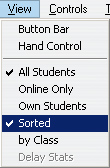 |
Select
VIEW > SORTED
from the menu bar. |
| By progress |
click on the
Progress header
in the header bar |
Lists all users who have entered the lesson by order of progress.
This option is only available from the Header bar. If the progress section is separated by mark columns, each progress section can be ordered independently.
Can be combined with any function that minimizes the display, like View By Class, View Own and View Online. |
|
| By score |
click on the
Mark header
in the header bar |
Sorts the students on the Tracker screen by score; the highest scoring student is displayed at the top of the screen.
If there is more than one Mark section, each section is sorted individually.
The total scores for each student out of the maximum possible (only for the questions taken) are shown at the right of the screen. As students take more questions or marks are given for items recorded, the scores and the maximum for the questions are updated. However, the list of students is not sorted again until Show scores is selected again.
Can be combined with any function from the Simplified display section below. |
| Restricted view |
Select
VIEW > ONLINE ONLY
from the menu bar |
Displays only the list of users currently using the lesson. Their name is highlighted in cyan.
Can be combined with View Own and View By Class to further limit the display and with any of the sorting options. |
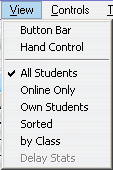 |
Select
VIEW > OWN STUDENTS
from the menu bar |
Reduces the list to only the students who have been registered by the instructor who is monitoring.
If the students were registered via an import file or by another instructor, selecting this option would display an empty Tracker, even if the students were added to the instructorís class.
Can be combined with View By Class and View Online Only to further limit the display and with any sorting options. |
Select
VIEW > BY CLASS, and then select the class name |
Displays only the list of students who belong to the class(es) selected.
For more information on how to select classes to view, read the Display By Class section.
Can be combined with View Own Students and View Online Only to further limit the display or with any of the sorting options. |
|
|
Display By Class
Just like classes can limit the menu displayed to the users, classes can also limit who the instructor can monitor:
- Instructors belonging to NO class at all will be able to monitor all students at any time.
- Instructors belonging to one or more class(es) will only be able to monitor the students who belong to the same class(es) as the instructor.
Example:
- Inst1 does not belong to any class.
- Inst2 belongs to Class A and ClassB
- Students from Class A, B, C and D all took TEST T.
- When INST1 monitors the TEST T, the Tracker displays all the students registered in the system including those from class A, B, C and D who entered the test, in the order they entered it.
-
When INST2 monitors the TEST T, the Tracker displays only the students from Class A and B who entered the test, in the order they entered it. INST2 will never be able to monitor students from class C or D
-
Both instructors can use the VIEW > BY CLASS option to limit the display to one or more classes, but whereas INST1 can select any (one or more) of the classes available in the system (A, B, C and/or D), INST2 can only limit the display to one of the 2 classes he/she belongs to (A or B).
|
|
VIEW > BY CLASS Procedure
From the menu bar, select VIEW > BY CLASS.
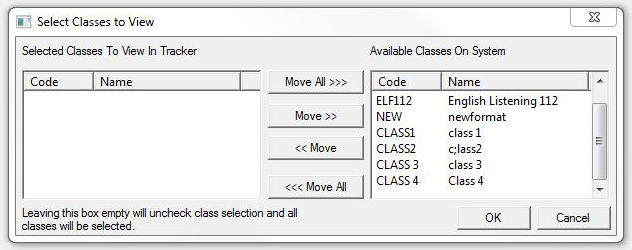 The Class selection window is in 2 sections:
The Class selection window is in 2 sections:
- The available system's class list on the right
- The selected class list on the left.
By default, no class is selected; therefore none is listed on the left panel.
 To select the class to view, either double click on the class name in the right panel and the class code will appear on the selected class section, or click on the class code, and then click the Move button.
To select the class to view, either double click on the class name in the right panel and the class code will appear on the selected class section, or click on the class code, and then click the Move button.
You can toggle the classes from one side to the other by selecting them with the mouse and using any of the Move buttons in the center section of the window.
Select OK When the selection is complete.
NOTE:
 It is possible to select more than one class to view.
It is possible to select more than one class to view.
 To return to the default Tracker view that includes all the system users, either move all classes from the Selected Classes section to the Available Classes section, or vice versa.
To return to the default Tracker view that includes all the system users, either move all classes from the Selected Classes section to the Available Classes section, or vice versa.
The Progress Area.
The entire section, made of coloured and/or empty cells, represents the entire lesson.
To the right of each student's name is a set of colour-coded boxes that show the student's progress through the lesson.
Unless the user list has been custumized, the first cells row represents the answers of the user who first connected to that lesson.
But if you click on the Progress header, the data below will be listed by order of progress for the section:
- The lines with the most correct answers first
- followed by the lines with the most answers, including wrong answers
- and finally the lines with less answers, or no answers at all.
Independently of the order in which the student is recording the answers (for example when a lesson is set to random mode, the student may have to answer the last item of the lesson before being presented with the very first item of the same lesson) the cells will always be placed in the order they appear in the planner.
Each box or cell corresponds to a lesson item that requires a response from the student. That is, Instruction, Teaching, and Conversation items do not have cells to represent them since the student cannot record in these items.
As soon as a student submits an answer (selects Next after recording in an item), the corresponding cell in the tracker is filled with the color that represents its content type. If the student skips an answer, the corresponding cell remains empty.
The cells' colour code is as follow:
The default display shows fixed size cells with icons.
Since a lesson can hold up to 240 items, all items cannot be displayed all at once on the same screen and a horizontal scroll bar at the bottom of the display area allows to view the rest of the lesson.
Alternatively, the cells can be displayed in smaller or larger sizes to either give a global view of the entire Tracker, or show additional details about each recorded cell.
 To change from the default display to a global display or a more detailed one, click on the icons
To change from the default display to a global display or a more detailed one, click on the icons  or
or  of the zoom bar located at the bottom right of the interface
or slide the zoom cursor at the desired level.
of the zoom bar located at the bottom right of the interface
or slide the zoom cursor at the desired level.
| Default display |
 |
Global Display
 |
 |
Detailed display
 |
 |
Answer Display section
All items that need to be evaluated by an instructor are represented in the progress area by a grey cell. This includes all items that required a recorded audio answer, and the write item.
For monitoring purposes, students' answers are divided into two types: Those the computers can mark, and those that need to be marked by an instructor.
Whereas a computer can correct and mark the answer from a Multiple Choice or a Fill-in question by comparing it to the instructor's answer, it cannot mark an answer to a question that does not meet these criteria.
These items are easily identified in the Tracker by their colour.
To view or listen to an answer that requires an instructors' evaluation, double click on its corresponding cell.
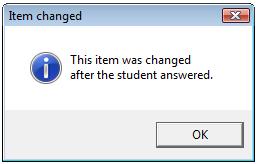
NOTE:
If you receive this message when clicking on a cell, the answer given by the student may no longer be valid, since the question has been changed after the answer was given.
However, at the time the answer was given, it might have been correct.
Listening to Audio Responses
While a student is in an item that requires a recorded response such as an Example, a Read, or an Ask item, the student may record the response, listen to it, and re-record it several times to try and get it right. The item indicator (or corresponding cell in the Tracker) remains empty (light grey).
Only when the student has completed a satisfactory recording and presses the Next button does the indicator turn grey to show that the recording is available for listening by the instructor.
The instructor can then listen to the student's answer and to the original audio that was recorded in the item by the instructor.
Students Recordings
To listen to students' recordings the instructor can:
- Using the mouse, select the item by clicking on it.
 Right click on the cell and select Listen to Student Response
Right click on the cell and select Listen to Student Response
-
Using the arrow keys of the keyboard, navigate to the cell you wish to listen to, and then press F2.
The Sound graph of the student response appears on lower part of the Tracker interface (Answer Display section) and the response starts playing automatically.
The Play and Pause buttons can be pressed to listen repetitively to the recording, or part of it.
Alternatively, the Play cursor can be moved by clicking the mouse on any spot on the volume display. The sound will play from that point.
Sample/Example Recordings
It might be necessary for the instructor to listen to the question the student was responding to or compare the student's recording with the audio example given:
 Press the Example button in the button bar.
Press the Example button in the button bar.
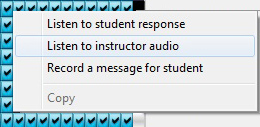 Right click again on the cell you are listening to and select Listen to Instructor Audio
Right click again on the cell you are listening to and select Listen to Instructor Audio
 The sound graph of the instructor's recording appears above the student's sound graph. To differentiate them, the audio part of the sound graph is displayed in cyan for the instructor, and green for the student.
The sound graph of the instructor's recording appears above the student's sound graph. To differentiate them, the audio part of the sound graph is displayed in cyan for the instructor, and green for the student.
To navigate from one recording to another, the instructor can:
- Use
 and
and  on either sound graph respectively.
on either sound graph respectively.
- Use
 and
and  in the button bar, where the Play button activates the student audio and the Example button activates the Instructor's audio.
in the button bar, where the Play button activates the student audio and the Example button activates the Instructor's audio.
- Click directly on either volume graph to place the sound cursor at the desired pace and activate it.
- Use any combination of the above methods.
Once the recording has been listened to:
- select the Exit button located at the top right corner of the Sound graph if you wish to exit the listening mode.
- Or click on the next item cell if you wish to continue listening to more answers.
- Alternatively, use the Arrow keys and the F2 key to navigate through the Tracker and listen to another item.
As soon as you exit the volume graph, or move to another cell, the previously selected item now appears in green to indicate that it has been listened to.
Note:
When entering a Tracker, you may notice that the Progress Display area of the Tracker is full and extends over the Answer Display area. If such is the case, when you click on the cell to listen to the student's recording, the progress display is reduced in size to allow space for the sound graph.
 If the cell you are listening to is located within the Answer Area (the lower part of the progress area), the entire Tracker row is then shifted above the Sound graph, thus allowing to view and listen to the other answers from that same student.
If the cell you are listening to is located within the Answer Area (the lower part of the progress area), the entire Tracker row is then shifted above the Sound graph, thus allowing to view and listen to the other answers from that same student.
 If necessary, a scroll bar will appear on the right side of the progress area to view the cell rows that were shifted upwards.
If necessary, a scroll bar will appear on the right side of the progress area to view the cell rows that were shifted upwards.
Viewing Students' Written Responses
The computer corrects the student's answers to Multiple Choice and Fill-in answers.
Question items that are answered correctly are displayed in cyan cells.
Question items that are incorrect are displayed in magenta cells.
These answers can be displayed for verification, independently of their status.
Multiple Choice Items
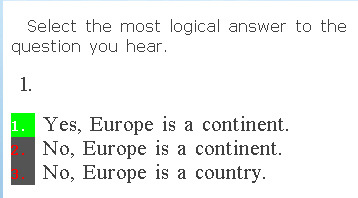 In the Tracker, the answer to a Multiple Choice is represented by a Cyan cell if it is correct or a magenta cell if the answer was incorrect.
In the Tracker, the answer to a Multiple Choice is represented by a Cyan cell if it is correct or a magenta cell if the answer was incorrect.
Double-clicking on one of these cells displays the question text and the answers. The response the student selected is shown on a red or on a green background.
 If the answer the student selected was correct, the answer is displayed on a green background.
If the answer the student selected was correct, the answer is displayed on a green background.
-
 Incorrect answers are displayed on a red background.
Incorrect answers are displayed on a red background.
The choices available and their status (correct or incorrect), as set by the instructor in the planner, are also displayed and colour coded:
-
 The answer(s) the instructor set as correct in the planner are displayed in green on a dark grey background.
The answer(s) the instructor set as correct in the planner are displayed in green on a dark grey background.
-
 The answer(s) the instructor had set as wrong in the planner are displayed in red on a dark grey background.
The answer(s) the instructor had set as wrong in the planner are displayed in red on a dark grey background.
 |
 |
In the example above, the student chose 1. for answer.
- 1. was the correct choice as set by the instructor.
- 2. and 3. were set as wrong answers in the planner.
Note that it is possible to set more than one answer as correct.
If such is the case, the answer that was set as correct, yet has not be chosen by the student as another possible true choice is displayed in green on Dark grey background. |
In the example above, the student chose 2. for answer.
- 2. was not the correct answer, and therefore the student's response is displayed on red background.
- 1. was set as correct in the planner but the student did not select it.
- 3. was set as an incorrect answer and the student did not select it.
|
Fill-In items
In the Tracker, answers to a Fill-in question are represented by cyan cells if correct, magenta cells when incorrect.
When clicking on one of these cells, the question text and the student's response is displayed.
 |
 |
| In the above image, the response given was correct. The student's answer is shown in the black text area. |
The Answer given in the above example is wrong. The student's wrong answer is shown in the black text box, the correct answer is shown under and is highlighted in green. |
Select the exit button on the Answer Display area to return to the full Tracker screen or select the next cell to view the next item.
Note:
 If the Progress Display area of the Tracker is full and expends over the Answer Display area, selecting the cell to view reduces the progress display area to allow space for the student answer.
If the Progress Display area of the Tracker is full and expends over the Answer Display area, selecting the cell to view reduces the progress display area to allow space for the student answer.
 If the cell you are viewing is located within the Answer Area (the lower part of the progress area), the entire Tracker row is then shifted above the Answer display area, thus allowing to view and listen to the other answers from that same student.
If the cell you are viewing is located within the Answer Area (the lower part of the progress area), the entire Tracker row is then shifted above the Answer display area, thus allowing to view and listen to the other answers from that same student.
 If necessary, a scroll bar will appear on the right side of the progress area to view the cell rows that were shifted upwards.
If necessary, a scroll bar will appear on the right side of the progress area to view the cell rows that were shifted upwards.
 Note also that when exiting a Fill in the blank or a Multiple Choice question, the cell's colour does not change.
Note also that when exiting a Fill in the blank or a Multiple Choice question, the cell's colour does not change.
Once the instructor has listened to or viewed the content, this cell turns green. The instructor may also give the item a mark at this point.
Leaving a Message
After listening to a response the instructor may decide to leave some feedback for the student, or decide that the student should redo the item. Pressing  either on the sound graph or in the button bar, or right clicking on the cell and selecting Record a Message for Student will initiate the message recording.
either on the sound graph or in the button bar, or right clicking on the cell and selecting Record a Message for Student will initiate the message recording.
The  may be used to pause and resume recording.
may be used to pause and resume recording.
The message volume graph is displayed in red.
Once the message is finished recording, and as soon as the instructor either exits the graph or selects the next cell, the following message is displayed:
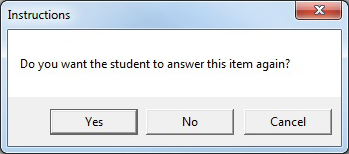
- OK - The student will be brought directly to this item when entering the lesson, will listen to the message, and will have to redo the exercise. The student will not be able to move to another exercise until this one is re-done.
- NO- The student will be brought directly to this item when entering the lesson, will hear the message, but redoing the exercise is optional.
- CANCEL- Cancels the message from the item.
As soon as an option is selected, the cells turn red to show it now includes a message.
Once the student has listened to the message, the cell turns yellow.
Any item on the Tracker Screen, whether the student has answered it or not, can be selected for a message.
Marking Tools section
When evaluating a test, instructors can mark the answers as long as the item has been assigned a mark in the Planner.
For more information on how to assign marks to items, please return to the Assigning Marks section of the previous Chapter.
Marking an Item
If an item was assigned a mark (1 to 10) in the lesson plan, the instructor can score the answer in the Tracker.
Multiple Choice and Fill-in questions are corrected and scored by the computer. A correct answer gets a full mark; an incorrect gets zero. If the item was set with the Part Mark option in the planner, a partially correct fill in the blank answer will get a partial mark.
For recorded answers, the computer does not mark the answer. The instructor must mark the answers manually.
 The student's mark and the maximum mark available for the item are displayed at the bottom left of the screen. The white mark box is empty if no mark has yet been given by the instructor.
The student's mark and the maximum mark available for the item are displayed at the bottom left of the screen. The white mark box is empty if no mark has yet been given by the instructor.
To mark the students work, the instructor must first click on the cell in the Tracker, and then simply type the digit corresponding to the mark desired. There is no need to click on the mark box, or to remove the existing mark if any. Simply type the number that will become the mark.
The score cannot be greater than the maximum mark allowed for the item.
Changing a mark
Marks can be edited at anytime simply by re-selecting the cell and typing a different number.
For items that are marked by the computers, it is also at the instructor's discretion to change the mark assigned. The computer might for example mark a missing capital letter as wrong, and the instructor decide to credit part of or the entire mark to the student.
The procedure is the same as for assigning a mark, select the item, and then simply type the desired number. There is no need to select the mark area first, it is pre-selected by default.
Display User Marks
Once the item has been evaluated and marked by the instructor, the mark can be displayed in the Tracker's cells on a per item basis.
 To do so, the instructor must set the Tracker display to its highest zoom level.
To do so, the instructor must set the Tracker display to its highest zoom level.
 Marks are displayed in the cell only if a mark was assigned for the item in the planner. If no mark was assigned to the item, the word None will show instead. If the item has a mark assigned, but the student did not record an answer, the cell will be empty.
Marks are displayed in the cell only if a mark was assigned for the item in the planner. If no mark was assigned to the item, the word None will show instead. If the item has a mark assigned, but the student did not record an answer, the cell will be empty.
For more information about the Tracker display levels or the cell colour codes, please refer to the Progress Area section of this manual.
Display Mark and Cumulative Mark columns.
Additional columns that display the user's marks subtotal and final marks, can be inserted in the Tracker by the instructor.
Mark Calculation Options

The mark out of the maximum mark assigned and the average in percentage are displayed in these columns.
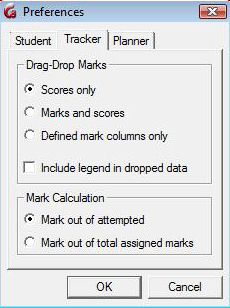
The marks shown in the mark columns may be calculated in two different ways. One option is to total the mark obtained by the student only on questions that were attempted. The other more traditional way is to total the mark out of the total assigned marks for all questions, even if they were not answered.
The EDIT > PREFERENCES > Tracker dialog tab allows the setting of the method for calculating the content of these columns.
These options are located in the Mark Calculation section of this form (lower section)
| Option |
Tracker display |
Description |
 |
 |
Gives the total mark and average in percentage of the items answered only. |
 |
 |
Gives the total mark and average in percentage of the total points available in that section. |
Adding Mark columns
Mark columns can be added to the Tracker by simply pressing the left mouse button over the Mark calculator  icon, and then while still holding the mouse button down, moving the mouse cursor to the location where the column should be.
icon, and then while still holding the mouse button down, moving the mouse cursor to the location where the column should be.

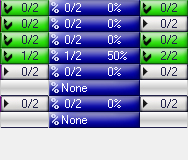 A thin vertical black cursor will show where the mouse is pointing.
A thin vertical black cursor will show where the mouse is pointing.
Upon release of the mouse button, the mark column will appear where the cursor was. It shows the subtotal of the marks earned by the student from the beginning until this column, or for items located between the last column and this one.
Cumulative Marks
Whereas subtotals give the score obtained within a defined section of the lesson, Cumulative marks show the student's total score from the first item answered in the Tracker to the item placed right before the mark column.
To display the student's cumulative score:
- First place a mark column in the Tracker (see procedure above).
-
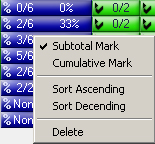
Right click on the mark column to bring up the popup selection menu.
- Select the Cumulative Mark option.
Follow the same steps as above to change a column that was previously selected as Cumulative Mark to Subtotal Mark
Cumulative Mark column can be differentiated from subtotal columns by their background color and icon:
Subtoatl Column
 |
 |
Cumulative mark Column
 |
 |
NOTE:
 The settings in the Mark Calculation section of the Tracker Preferences dialog also apply to the cumulative results.
The settings in the Mark Calculation section of the Tracker Preferences dialog also apply to the cumulative results.
Export Evaluation Marks.
The marks obtained by the users can be made into a report that can be exported directly from CAN-8 into any application that read .csv files (Spreadsheet, word processor, etc,...)
Export Procedure
The report is created by selecting a number of cells for some (or all) students in the Tracker and dragging this out to another application
it is to be used in.
Use the Next Step button below to go through the detailed steps.

|

|
|
Step 1 - Selecting
Left click and hold the mouse button down on the first cell of the group of users you wish to export the marks. |
|
Alternative method:
- Follow the procedure above till step 3
- Right click on the selection.
- Select COPY in the popup contextual menu.
- Open the spreadsheet, or the software intended.
- Place the mouse cursor where the data should be placed
- Select EDIT > PASTE
Export Format
There are 3 selectable formats for these reports:
- Scores Only format: Only export student names, item names, and per item scores.
- Mark Out-of format: exports student names, item names, per item scores and mark the item is out of.
- Defined Mark Columns Only format: In this format, only the mark summary column totals and the available score are stored.†

The report format is selected in the Tracker Tab of the Preferences
dialog box accessed through EDIT > PREFERENCES from the menu bar.
These preferences are set in the instructor's profile and can be changed at any time.
The system will keep the last settings selected as the default settings next time the instructor signs in.
1. Scores Only
In this format, only the mark for each item is stored.†It is
assumed that the total mark each item is out of is either known or un-necessary.
Report fields are as follow:
| First line |
Lesson_Name |
Lesson_name |
Type |
Ex. 1 |
Ex. 2 |
... |
Ex. X |
| Contains |
The name of the lesson |
The name of the lesson |
Type of report created:
O, P or S |
Name of the first item |
Name of item number 2 |
... |
Name of item number X |
| Subsequent lines |
Student_name |
Student_ID |
O |
0 to 9 |
0 to 9 |
... |
0 to 9 |
| Contains |
The name of the student |
The student's user ID |
Indicates a Score Only type |
The score received for the first item |
The score received for the second item |
... |
The score received for item X |
Example
|
 |
2. Mark Out-of format
In this format, each field shows the mark the student received on the item and the
maximum available mark on the item for all items in the Tracker.
| First line |
Lesson_Name |
Lesson_name |
Type |
Ex. 1 |
Mark Out Of |
Ex. 2 |
Mark out of |
etc... |
| Contains |
The name of the lesson |
The name of the lesson |
Type of report created: O, P or S |
Name of the first item |
Maximum Mark for item 1 |
Name of the second item |
Maximum mark for item 2 |
Repeat until last item exported |
| Subsequent lines |
Student_name |
Student_ID |
P |
0 to 9 |
0 to 9 |
0 to 9 |
0 to 9 |
etc... |
| Contains |
The name of the student |
The student user ID |
Indicates a Score Only type |
Mark received for the first item |
Mark that item 1 is out of |
Mark received for second item |
Mark that item 2 is out of |
Repeats until last item exported |
Example
|
 |
3. Mark summary format
In this format, only the mark summary column totals and
the available score are exported.
In order to export in this format, mark columns must be defined in the Tracker first.
| First line |
Lesson_Name |
Lesson_Name |
Type |
Mark |
Out Of |
Percent |
C |
Cumulative mark |
Out Of |
Percent |
| Contains |
The name of the lesson |
The name of the lesson |
Type of report created: O, P or S |
Mark obtained in the first subtotal |
Max. Mark for that section |
Percentage achieved in that section |
Indicates the following column is a cumulative mark. |
Cumulative mark obtained |
Maximum mark for the section |
Cumulative percentage |
| Subsequent lines |
Student_name |
Student_ID |
S |
0 to 9 |
0 to 9 |
0 to 100 |
C |
0 to 9 |
0 to 9 |
0 to 100 |
| Contains |
The name of the student |
The student user ID |
Indicates a Summary format record |
Mark received as a subtotal |
Score the subtotal is out of |
Percentage for the section |
Indicates a Cumulative mark follows |
Cumulative mark |
Score the mark is out of |
Cumulative percentage |
Example
|
 |
Include Legend
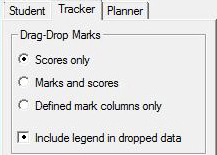 The Include Legend In Dropped Data option is located in the same section of the Preferences box. Checking this option will add an extra line to the exported data.
The Include Legend In Dropped Data option is located in the same section of the Preferences box. Checking this option will add an extra line to the exported data.
The legend is placed at the end of the report.
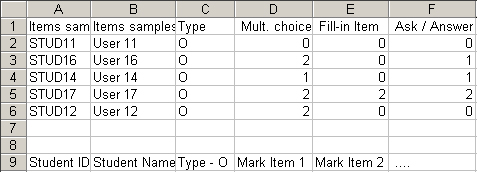
Lesson Modes
Unless otherwise specified, the lesson is used by default as a drill and practice.
Students who access the practice lesson can record answers and take questions. In this mode, the results (correct, incorrect, and marks) for each question are available to the student. The student item menu shows correctly answered Multiple Choice and Fill-in questions in green and incorrectly answered ones in red. Recorded answers are displayed in green.
However, the instructor can administer the lesson material as a test instead of practice. The test sequence proceeds through the stages of students waiting for the test to begin, taking the test, and finally reviewing the results.
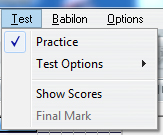 The Test menu is accessed from the menu bar. The Test menu options allow an instructor to set the lesson to practice or to administer supervised tests to a class.
The final marks for the test, including rank in class, can be displayed to the students as well.
The Test menu is accessed from the menu bar. The Test menu options allow an instructor to set the lesson to practice or to administer supervised tests to a class.
The final marks for the test, including rank in class, can be displayed to the students as well.
When the test menu is displayed, one of the first four options will be checked to indicate which one is currently in effect.
The Test menu options are:
1. Practice
In drill and practice students are given feedback by the colour of the items on the student menus.
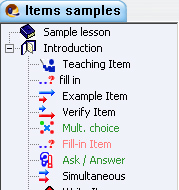
- Green item titles are for correctly answered Multiple Choice and Fill-in questions and for all recorded answers, corrected or not.
- Red item titles are incorrect Multiple Choices and Fill-in answers.
- Black titles mean the item has not been answered.
In this illustration, the 3 first items have not been answered, the next 3 have, but 2 are correct and one is wrong.
NOTE:
 When in practice mode, depending which Feedback option was selected in the Planner, the student may or may not receive feedback when taking a Multiple Choice or Fill-in Item.
When in practice mode, depending which Feedback option was selected in the Planner, the student may or may not receive feedback when taking a Multiple Choice or Fill-in Item.
2. Test Options
There are 5 test options.
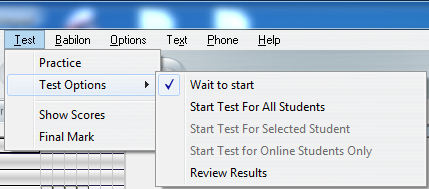
Wait to start
When this option is set, students cannot access the lesson. Only the instructor can unlock it.
-
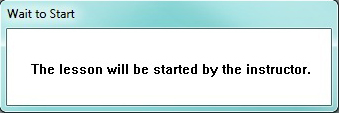
A message indicating that the test is not available is displayed to the student. Students scheduled for a test must wait until the instructor changes the lesson mode to Take Test at which point the test will start automatically.
- In the Tracker, students who are waiting to take the test show as online (highlighted blue) in the Tracker. The wait to start status is shown in the Tracker's information field at the bottom of the screen.

As soon as the lesson is placed in Test mode, the Wait to Start message will disappear from the students' screens and the test will start.
There are 3 options for testing the users.
Start Test For All Students
 This mode opens the test to all users who enter that lesson, independently of when they enter it, and will remain available until it is placed in the Wait to Start mode again.
This mode opens the test to all users who enter that lesson, independently of when they enter it, and will remain available until it is placed in the Wait to Start mode again.
If it is important to either start students at the same time, or select which students can access the test, please read about the options Start Test For Selected Student and Start Test For Online Students Only .
When in Test mode, independently of which Feedback option was selected in the Planner, the student will not receive feedback when taking a Multiple Choice or Fill-in Item. Answered items titles are in green, even if the answer is wrong, unanswered item are in black.
To stop the test mode, or make the test unavailable, select the Wait to Start option again.
Start Test for Selected Student
If testing needs to be done on an individual basis, it is possible to start one student at a time, without permitting unauthorized access to the test to the other users.
The procedure is as follows:
- The lesson is on Wait to start.

When the student logs in and selects the lesson they will see the Waiting... window.
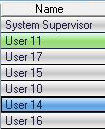
Once the student is in the lesson, the name is highlighted in blue in the Tracker's name section.
The instructor then selects the name of the user that will take the test by simply clicking on it.
In this illustration the instructor selected User 14

To start the test, the instructor selects Test Options from the menu bar, and then Start Test For Selected Student. This starts the test for this student and this student only.
-
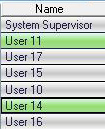
Once the instructor started the test for the student, the student's name is highlighted in green in the Tracker.
In the example on the left, there are 2 users started in this test: User 11 and User 14.
Note:
 There is no way to stop the test once the student has begun.
There is no way to stop the test once the student has begun.
Start Test for Online Students Only
The Start Test for Online Students Only option is a variation of Start test for all Students
Whereas Start test for all Students makes the test available to all users who access the lesson until the test is placed back in Wait to Start mode, Start Test for Online Students Only makes the test available to users who are waiting to start (Highlighted in blue in the Tracker) at the time the test is started.
Users attempting to access the test once it has been started will receive the Wait to Start window and will be denied access to the test until the instructor starts them individually.
 To use the Start Online Students function:
To use the Start Online Students function:
- simply highlight one of the students whose name is highlighted in blue.
- select the option Start Test for Online Students Only from the test menu.
- All users whose names were previously highlighted blue (showing online) will now be highlighted in green (taking the test).
Note:
 Users entering the lesson after the test is started will be highlighted in blue as they will not be able to access the test.
Users entering the lesson after the test is started will be highlighted in blue as they will not be able to access the test.
 It is possible to start another group or individual students using the procedure for Start Test For Selected Student or Start Test for Online Students while others are already taking the test.
It is possible to start another group or individual students using the procedure for Start Test For Selected Student or Start Test for Online Students while others are already taking the test.
Review Results
At the end of a test the instructor can select Review Results. This mode is indicated in the information area at the bottom of the Tracker interface:

This ends the test for students who are not finished.
Students can see the questions, and can see their own answers if they previously took that test, but can no longer record or change previous answers, as indicated in the item's header bar:

Any attempt to record or type an answer while the test is in review mode will bring the warning message illustrated.
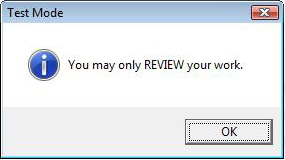
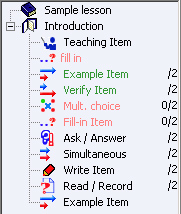
Multiple Choice and Fill-in Questions that were correct are show in green; they are shown in red if the answer was incorrect. Since the items are corrected by the system, the marks for these items are available right away and displayed also.
All other types of items that need to be corrected and marked by instructors are displayed in green if they have been answered. If the Instructor has already marked them, the score shows beside the item name. If the answer has not been marked yet, only the score the answer is out of is displayed.
Items not taken are displayed in black.
3. Show Scores
Selecting this option sorts the students on the Tracker screen by score.
The highest scoring student is displayed at the top of the screen.
The scores for each student out of the maximum possible (only for the questions taken) are shown at the right of the screen. If students continue to work and answer more questions, or the instructor assigns more marks, the scores and the maximum for the questions are updated. However, the list of students is not sorted again until Show Scores is selected again.
This option has no effect on the students themselves.
4. Final Mark
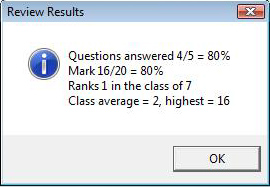 Selecting this option when the test is in the Review Results stage will display the final marks to the students.
Selecting this option when the test is in the Review Results stage will display the final marks to the students.
Only the Class Average and Highest (Mark) is common to all students who took that test. All other information like Mark and Rank are given individually.
Each student sees his\her own mark out of the maximum possible in the test
The Final Mark is displayed to the student when the Review Results or Practice options are selected.
Only deleting the student's data from the Tracker will remove a final mark.
Note:
 Although the final mark is displayed when the mode is changed back to practice, it will not change if the student answers further questions.
Although the final mark is displayed when the mode is changed back to practice, it will not change if the student answers further questions.
Phone
Calling a Student
While monitoring a test or a lesson, it might become apparent that one of the students needs assistance, either because that student placed a call request (student background turns red) or because the instructor notices skipped items or irregularities in the answers.
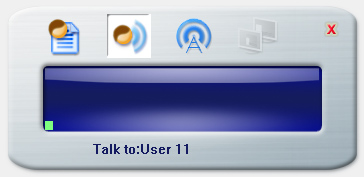 The Net Phone can be used to initiate a real time conversation between an instructor and a student. Students cannot initiate that call; only instructors can. However, students can send a call request.
The Net Phone can be used to initiate a real time conversation between an instructor and a student. Students cannot initiate that call; only instructors can. However, students can send a call request.
A similar phone is displayed on the student's screen asking them to speak to the instructor.
To terminate the call to the student, the instructor presses the Exit key.
There are several ways to initiate a call to a student:
- If the students is in the lesson, the Instructor can initiate the call from the Tracker by either
-

The instructor first places the cursor on the name of the user to call, and then selects Phone > student from the menu Bar.
The Net Phone showing the instructor's voice in the volume display appears on the screen.
-

Select the student to call then the Phone icon in the Left button bar. The Net Phone will start.
- If the student is NOT in the lesson, the instructor can initiate the call by:
 selecting the Phone icon
selecting the Phone icon
-
 then the Student List icon
then the Student List icon
- and finally double click on the user name in the list displayed. This list only displays users that are online at the time.
Note:
 The instructor can talk online to the students who are signed on and using the network. Communication is over the network wires directly to the student's computer. As the voice is transmitted in real time over the network, the message cannot be saved or edited. Students who sign on later will not receive it.
The instructor can talk online to the students who are signed on and using the network. Communication is over the network wires directly to the student's computer. As the voice is transmitted in real time over the network, the message cannot be saved or edited. Students who sign on later will not receive it.
 The SV Net phone can be used to contact a remote student, someone connecting from home for example. The user does not have to be on the same network than the instructor, as long as they are signed on the same server.
The SV Net phone can be used to contact a remote student, someone connecting from home for example. The user does not have to be on the same network than the instructor, as long as they are signed on the same server.
Interrupting the Class
The instructor may also speak in real time to the entire class at the same time using the Phone Broadcast function.
This function can be accessed:
-
 By selecting Phone > Broadcast from the menu bar.
By selecting Phone > Broadcast from the menu bar.
-
 Clicking on the phone icon from the left button bar,
Clicking on the phone icon from the left button bar,
 then the broadcast icon on the SV Phone interface.
then the broadcast icon on the SV Phone interface.
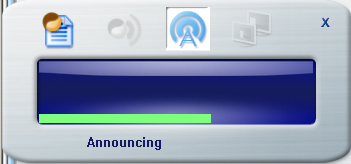
The SV Net Phone appears on the screen showing the instructor's voice.
Each of the CAN-8 users in an active session will receive an on screen message telling them to Listen to the Announcement.
Note:
 All users who are signed in the CAN-8 language lab software which are on the same network subnet will see this message and hear the instructor's voice.
All users who are signed in the CAN-8 language lab software which are on the same network subnet will see this message and hear the instructor's voice.
 If a CAN-8 user is recording or listening to an item at the time the broadcast is initiated, it is paused until the broadcast is terminated.
If a CAN-8 user is recording or listening to an item at the time the broadcast is initiated, it is paused until the broadcast is terminated.
 Students cannot terminate a broadcast from an instructor
Students cannot terminate a broadcast from an instructor
 To terminate this broadcast the instructor must press the Exit button.
To terminate this broadcast the instructor must press the Exit button.
 As opposed to the CALL STUDENT phone function, broadcasting cannot be done over the Internet.
As opposed to the CALL STUDENT phone function, broadcasting cannot be done over the Internet.
Exporting students answers
 The Tracker includes the capacity of
exporting students' recorded answers into wave files, and save them locally, on a network share or a removable disk.
The Tracker includes the capacity of
exporting students' recorded answers into wave files, and save them locally, on a network share or a removable disk.
The instructor may choose to export
- one specific answer from a student
- all the answers a student has recorded in a lesson Plan.
- all the recorded answers from all the students shown in that Tracker.
Exporting an answer
From the Tracker, select the student's answer you wish to export by
clicking once on the corresponding grey box.
Next select File-->Export-->Single Answer and the Export Item form will open:

- In the Drives section, select the drive you wish to save the answer on, and then locate
the appropriate folder by scrolling in the Folders section. You may also use the
Network or browse button if you wish to save this file on a network share.
- The File Type field shows wave by default.
- Type a name for the file in the File Name field. This field is mandatory.
- Finally, Click OK to finalize the process.
Exporting All of a student's Answers
From the Tracker
- Click on the name of the student whose answers you wish to export.
- Select FILE > EXPORT > Selected Student Answers
In the Export Item box:

- In the Drives section, select the drive you wish to save the answers on,
- then locate the appropriate folder by scrolling in the Folders section. You may also use the Network button if you wish to save this file on a network share.
- The File Type field:
By default this field is pre-set as
Wave type. Leave it as is.
- This export function is automated to export more than one file at a time and each answer from the student will be saved as a different wave file. Each file will therefore be assigned a different name by the system.
In the File Name field, enter the name of a NEW FOLDER that will be created during the export and where these files will be saved.
Since this is a folder, do not add the .wav extension in this field.
Do not type in the name of an existing folder, as this will
bring an error box:
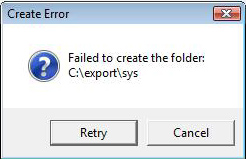 If the error message appears, select Retry, rename your folder
and press OK again.
If the error message appears, select Retry, rename your folder
and press OK again.
- Finally, Click OK to finalize the process.
To locate these new files:
- Navigate to the path you gave in the Drive and Folder section of the export form.
- Look for the folder that was created during the export.
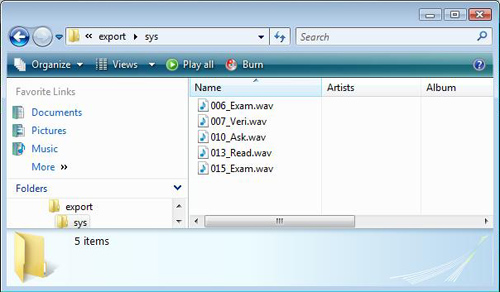 The wave files have
automatically be saved in that newly created folder.
The wave files have
automatically be saved in that newly created folder.
The names of these files, assigned by
the system is composed of their position in the Planner, followed by an under-score and the 4 first letters of this item's name in the Planner, as illustrated.
File 006_Exam.wav is the answer to the 6th item in the planner titled Example Item.
Note:
 if the item's name in the Planner includes an accented character, this character will also be replaced by an underscore since accentuation is not permitted in the 8.3 file name standard.
if the item's name in the Planner includes an accented character, this character will also be replaced by an underscore since accentuation is not permitted in the 8.3 file name standard.
Exporting all students' answers
 From the Tracker, select FILE --->EXPORT --> All Answers
From the Tracker, select FILE --->EXPORT --> All Answers
the Export Item box
will open:

- In the Drives section, select the drive you wish to save the answers on.
- Locate
the appropriate folder by scrolling in the Folders section. You may also use
the Network button if you wish to save this file on a network share.
- The file type field is pre-set as
Wave type.
- In the File Name field, enter the name of the folder that you wish to create. Since this is a folder, do not add the .wav extension in this field. If the folder already exists, you will get an error box:

Select Retry, rename your folder
and press OK again.
- Finally, Click OK to finalize the process.
The system has now created the new folder (in the illustration above, the folder 2010jan01).
The system will also create a sub-folder for each student and place it inside that new folder. The names assigned to the students' folders by the system consists of the number that was assigned to the user when they were created on the system.(see User Serial Number in the List Display).
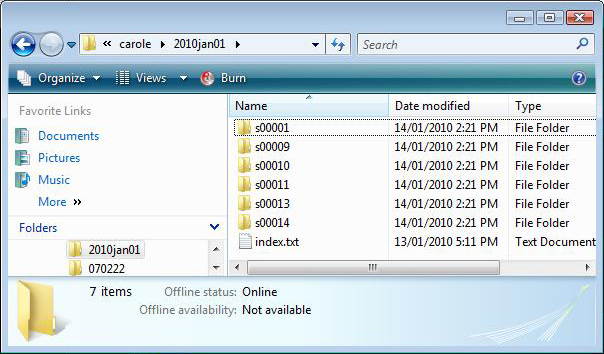
An index.txt file is also created in the same folder as the student sub-folders containing the user number and corresponding user name for each folder.

Each sub-folder includes several wave files, one for each answer that this student recorded in that lesson.
The names of these files are composed of 3 digits, corresponding to the item's position in the Planner, followed by an underscore and then the 4 first letters
of the item's name in the Planner
Note:
 If the item's name in the Planner includes an accented character, this character
will also be replaced by an underscore as
accentuation is not permitted in the 8.3 file name standard.
If the item's name in the Planner includes an accented character, this character
will also be replaced by an underscore as
accentuation is not permitted in the 8.3 file name standard.
Printing the Tracker
Results can also be printed to either keep as records or hand out to the students.
All information present in the Tracker, including the score per item, subtotals and cumulative marks if applicable, is included in the Tracker print out:
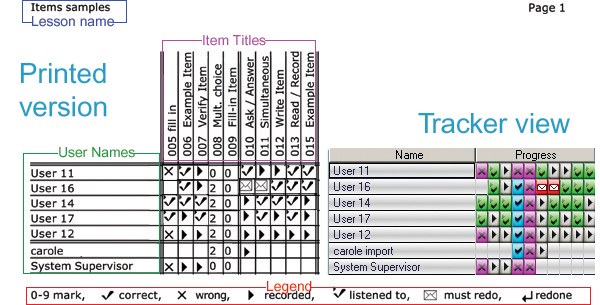
Note:
 Where items have been reviewed and marked by the instructor, their score rather than their status is shown in the print out. So instead of showing an X for Wrong Answer on a wrong Multiple Choice item, a score of 0 will show.
Where items have been reviewed and marked by the instructor, their score rather than their status is shown in the print out. So instead of showing an X for Wrong Answer on a wrong Multiple Choice item, a score of 0 will show.
 To show the subtotals and/or cumulative marks in the printout, the instructor must first display them in the Tracker.
To show the subtotals and/or cumulative marks in the printout, the instructor must first display them in the Tracker.
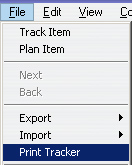 To access the Tracker printer function, select
To access the Tracker printer function, select
File > Print Tracker from the menu bar.
Deleting Student's data
Once the student's data has been corrected or reviewed, it can be deleted from the Tracker. Data deletion is permanent. If it is necessary to keep a copy of their recordings, refer to the Exporting Data section of this Chapter.
 Tracker data can be deleted on a per user basis:
Tracker data can be deleted on a per user basis:
- Select a student by clicking on the name.
- Select File > Delete > Selected User from Tracker.
- Confirmation is required before the data is deleted. Select OK at the prompt.
To delete all students shown in the Tracker and their data:
- Access the File > Delete > All Users From Tracker option from the menu bar.
- Confirmation is required before the data is deleted. Select OK at the prompt.
All student data will be deleted and the screen will be cleared.
Note:
 Deleting users from the Tracker does not delete them from the system.
Deleting users from the Tracker does not delete them from the system.
 Deleting users' data from a Tracker does not affect their Data in other Trackers.
Deleting users' data from a Tracker does not affect their Data in other Trackers.
 When a student's data is deleted, all the student's progress and recorded sound files (for this lesson only) are deleted.
When a student's data is deleted, all the student's progress and recorded sound files (for this lesson only) are deleted.
 When a student's data is deleted, the disk space used to store the recorded files will become available for other uses.
When a student's data is deleted, the disk space used to store the recorded files will become available for other uses.
 Students who are currently signed on and using the lesson are not affected by either of these options. Their data cannot be deleted until they have exited the lesson.
Students who are currently signed on and using the lesson are not affected by either of these options. Their data cannot be deleted until they have exited the lesson.
Top
 First select a lesson from the main CAN-8 menu, and then press the Tracker icon located in the tool bar on the left of the interface.
First select a lesson from the main CAN-8 menu, and then press the Tracker icon located in the tool bar on the left of the interface.
 Select the lesson title from the main CAN-8 menu, right click on it, and then select Track Item from the contextual menu.
Select the lesson title from the main CAN-8 menu, right click on it, and then select Track Item from the contextual menu.
 Select the lesson title from the main CAN-8 menu, and then select File > Track Item from the menu bar.
Select the lesson title from the main CAN-8 menu, and then select File > Track Item from the menu bar.
 If the Tracker button or Track Item option is greyed out,
check that the lesson is selected (highlighted blue in the tree menu).
If the Tracker button or Track Item option is greyed out,
check that the lesson is selected (highlighted blue in the tree menu).
 and not a submenu, an internal command, or some other type of CAN-8 function.
and not a submenu, an internal command, or some other type of CAN-8 function.

 The currently selected item is identified at the bottom left corner of the screen. The item index in the plan is followed by the item name (or title). The mark given for the response (if any) is shown over the assigned mark (if any) for the item.
The currently selected item is identified at the bottom left corner of the screen. The item index in the plan is followed by the item name (or title). The mark given for the response (if any) is shown over the assigned mark (if any) for the item.
 This allows to easily switch from a Tracker to a lesson, a planner or even another Tracker without having to exit the Tracker screen.
This allows to easily switch from a Tracker to a lesson, a planner or even another Tracker without having to exit the Tracker screen.
 can be easily identified by the icon located on their left. Since up to 7 tabs (including Planners, Trackers and Students Programs tabs) can be opened simultaneously,
this helps locate opened Trackers at a glance. The lesson's name also shows on that tab for more clarity.
can be easily identified by the icon located on their left. Since up to 7 tabs (including Planners, Trackers and Students Programs tabs) can be opened simultaneously,
this helps locate opened Trackers at a glance. The lesson's name also shows on that tab for more clarity.


 If the student is currently signed on, the name is displayed in Black on a blue background.
If the student is currently signed on, the name is displayed in Black on a blue background.
 If the student is currently taking a test, the name is displayed in Black on a green background.
If the student is currently taking a test, the name is displayed in Black on a green background.
 If the student has accessed the lesson in the past but is no longer signed on, the name is displayed in black on a white background.
If the student has accessed the lesson in the past but is no longer signed on, the name is displayed in black on a white background.
 If the student is calling for help the name is displayed in black on a red background.
If the student is calling for help the name is displayed in black on a red background.




 The Class selection window is in 2 sections:
The Class selection window is in 2 sections: To select the class to view, either double click on the class name in the right panel and the class code will appear on the selected class section, or click on the class code, and then click the Move button.
To select the class to view, either double click on the class name in the right panel and the class code will appear on the selected class section, or click on the class code, and then click the Move button.
























 If no mark was assigned to the item, the largest cell will display None instead of the score.
If no mark was assigned to the item, the largest cell will display None instead of the score.  To change from the default display to a global display or a more detailed one, click on the icons
To change from the default display to a global display or a more detailed one, click on the icons 



 Right click on the cell and select Listen to Student Response
Right click on the cell and select Listen to Student Response  Press the Example button in the button bar.
Press the Example button in the button bar.
 Right click again on the cell you are listening to and select Listen to Instructor Audio
Right click again on the cell you are listening to and select Listen to Instructor Audio
 The sound graph of the instructor's recording appears above the student's sound graph. To differentiate them, the audio part of the sound graph is displayed in cyan for the instructor, and green for the student.
The sound graph of the instructor's recording appears above the student's sound graph. To differentiate them, the audio part of the sound graph is displayed in cyan for the instructor, and green for the student.
 and
and  on either sound graph respectively.
on either sound graph respectively.
 In the Tracker, the answer to a Multiple Choice is represented by a Cyan cell if it is correct or a magenta cell if the answer was incorrect.
In the Tracker, the answer to a Multiple Choice is represented by a Cyan cell if it is correct or a magenta cell if the answer was incorrect.
 If the answer the student selected was correct, the answer is displayed on a green background.
If the answer the student selected was correct, the answer is displayed on a green background.
 Incorrect answers are displayed on a red background.
Incorrect answers are displayed on a red background.
 The answer(s) the instructor set as correct in the planner are displayed in green on a dark grey background.
The answer(s) the instructor set as correct in the planner are displayed in green on a dark grey background.  The answer(s) the instructor had set as wrong in the planner are displayed in red on a dark grey background.
The answer(s) the instructor had set as wrong in the planner are displayed in red on a dark grey background. 



 either on the sound graph or in the button bar, or right clicking on the cell and selecting Record a Message for Student will initiate the message recording.
either on the sound graph or in the button bar, or right clicking on the cell and selecting Record a Message for Student will initiate the message recording.

 The student's mark and the maximum mark available for the item are displayed at the bottom left of the screen. The white mark box is empty if no mark has yet been given by the instructor.
The student's mark and the maximum mark available for the item are displayed at the bottom left of the screen. The white mark box is empty if no mark has yet been given by the instructor.
 To do so, the instructor must set the Tracker display to its highest zoom level.
To do so, the instructor must set the Tracker display to its highest zoom level.
 Marks are displayed in the cell only if a mark was assigned for the item in the planner. If no mark was assigned to the item, the word None will show instead. If the item has a mark assigned, but the student did not record an answer, the cell will be empty.
Marks are displayed in the cell only if a mark was assigned for the item in the planner. If no mark was assigned to the item, the word None will show instead. If the item has a mark assigned, but the student did not record an answer, the cell will be empty.






 icon, and then while still holding the mouse button down, moving the mouse cursor to the location where the column should be.
icon, and then while still holding the mouse button down, moving the mouse cursor to the location where the column should be.
 A thin vertical black cursor will show where the mouse is pointing.
A thin vertical black cursor will show where the mouse is pointing. 






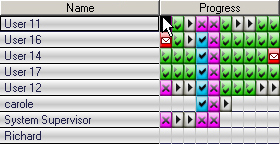



 The Include Legend In Dropped Data option is located in the same section of the Preferences box. Checking this option will add an extra line to the exported data.
The Include Legend In Dropped Data option is located in the same section of the Preferences box. Checking this option will add an extra line to the exported data.

 The Test menu is accessed from the menu bar. The Test menu options allow an instructor to set the lesson to practice or to administer supervised tests to a class.
The
The Test menu is accessed from the menu bar. The Test menu options allow an instructor to set the lesson to practice or to administer supervised tests to a class.
The 



 This mode opens the test to all users who enter that lesson, independently of when they enter it, and will remain available until it is placed in the Wait to Start mode again.
This mode opens the test to all users who enter that lesson, independently of when they enter it, and will remain available until it is placed in the Wait to Start mode again.



 To use the Start Online Students function:
To use the Start Online Students function:




 Selecting this option when the test is in the Review Results stage will display the final marks to the students.
Selecting this option when the test is in the Review Results stage will display the final marks to the students.
 The Net Phone can be used to initiate a real time conversation between an instructor and a student. Students cannot initiate that call; only instructors can. However, students can
The Net Phone can be used to initiate a real time conversation between an instructor and a student. Students cannot initiate that call; only instructors can. However, students can 

 then the Student List icon
then the Student List icon
 By selecting Phone > Broadcast from the menu bar.
By selecting Phone > Broadcast from the menu bar.
 then the broadcast icon on the SV Phone interface.
then the broadcast icon on the SV Phone interface.

 The Tracker includes the capacity of
exporting students' recorded answers into wave files, and save them locally, on a network share or a removable disk.
The Tracker includes the capacity of
exporting students' recorded answers into wave files, and save them locally, on a network share or a removable disk.


 If the error message appears, select Retry, rename your folder
and press OK again.
If the error message appears, select Retry, rename your folder
and press OK again.
 The wave files have
automatically be saved in that newly created folder.
The wave files have
automatically be saved in that newly created folder.





 To access the Tracker printer function, select
To access the Tracker printer function, select
 Tracker data can be deleted on a per user basis:
Tracker data can be deleted on a per user basis: